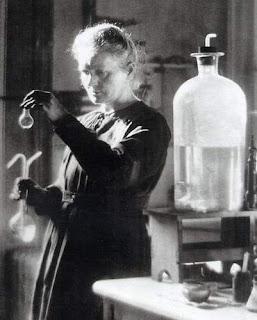Mulheres na Ciência
Mulheres na Ciência
O campo de estudo que se
ocupa a investigar os fenômenos científico-tecnológicos e sua relação com o
contexto social é comumente chamado de estudos sociais da ciência. E parte do
princípio que “os fatores econômicos, políticos e culturais têm influência
sobre as mudanças científico-tecnológicas; e as mudanças
científico-tecnológicas têm conseqüências para a sociedade e seu meio
ambiente.” (SANTOS, 2006) A noção da construção do saber científico como
objetivo, universal e neutro deu lugar a interpretação de que a ciência que é
produzida em um dado local em uma determinada época é fruto de um contexto
social e histórico específico. Com essa nova abordagem de estudo com relação a
ciências e seus valores como a relação entre ciência e gênero (participação das
mulheres nas atividades científicas). (SILVA, 1998, p.11)
Durante muitos anos as
mulheres permaneceram confinadas ao “saber doméstico que consistia na leitura e
na escrita, algumas noções de cálculos necessárias ao bom funcionamento da
economia familiar”. (TOSI, 1998, p.379)
Apesar desse quadro
desfavorável, muitas mulheres tiveram participação nas atividades científicas
ou técnicas.
“essas
mulheres, pertencentes às classes nobres ou burguesas, [que] tiveram a chance
de receber uma boa educação, o que permitia transpor barreiras e interdições.
No entanto, ficaram relegadas à condição marginal de assistentes ou, no melhor
dos casos, de colaboradoras de cientistas conhecidos, ficando freqüentemente
ignoradas para a posteridade”. (TOSI, 1998, p.380)
Porém, existem casos em
que as mulheres conseguiram transpassar as barreiras e ganharam reconhecimento
internacional. Um exemplo muito conhecido é Marie Curie (1867-1934) que em
conjunto com o marido Pierre Curie realizou pesquisas no campo da física e da
química, ganhando com o marido o Prêmio Nobel de física pela descoberta do
campo de radioatividade. Posteriormente, Marie ganhou um Prêmio Nobel de
química, dessa vez sozinha, por sua descoberta dos elementos químicos rádio e
polônio. Marie também chegou a ser chefe do Laboratório de Física da Sorbonne
tendo inegavelmente sua capacidade profissional reconhecida e valorizada.
---
English version
Women in science
The field of study that deals with investigating the scientific and technological phenomena and their relationship with the social context is often called social studies of science. And assumes that "the economic, political and cultural influence on scientific and technological changes, and scientific and technological changes have consequences for society and its environment." (Santos
The notion of the construction of scientific knowledge as objective, neutral and universal interpretation gave rise to that science which is produced in a given place at a particular time is the result of a specific historical and social context. With this new approach to learning about the science and its values as the relationship between science and gender (women's participation in scientific activities). (SILVA, 1998, p.11)
For many years women were confined to "know that home was in reading and writing, some basic calculations necessary for the proper functioning of the family economy." (TOSI, 1998, p.379)
Despite this unfavorable scenario, many women have participated in the scientific or technical.
"These women, belonging to nobles or bourgeois classes, [which] had the chance to receive a good education, which allowed overcoming barriers and prohibitions. However, they were relegated to marginal status of assistants or, at best, of collaborating scientists known, often being ignored for posterity." (TOSI, 1998, p.380)
However, there are cases in which women have run through the barriers and gained international recognition. A well-known example is Marie Curie (1867-1934) who together with her husband Pierre Curie carried out research in physics and chemistry, with her husband winning the Nobel Prize in physics for his discovery of the field of radioactivity.
Later, Marie won a Nobel Prize in chemistry, this time alone, for his discovery of the chemical elements radium and polonium. Marie also became head of the Physics Laboratory at the Sorbonne with their professional undeniably recognized and valued.
Referência / Reference
SANTOS, Lucy Woellner dos; ICHIKAWA, Elisa Yoshie. Para iniciar o debate sobre o feminino na
relação ciência e sociedade. p. 3-23. IAPAR. Londrina. 2006.
SILVA, Elisabeth Bortolaia. Des-construindo
gênero em ciência e tecnologia. Caderno Pagu. (10). P.7-20. 1998. Campinas,
São Paulo.
TOSI,
Lúcia. Mulher e ciência - A Revolução
científica, a caça às bruxas e a ciência moderna. In: Cadernos Pagu. (10) pp.369-397. 1998. Disponível em: <http://www.pagu.unicamp.br/files/cadpagu/Cad10/pagu10.14.pdf>
Acesso: 23 abr. 2010.
Imagem. Marie
Curie. Disponível em: <http://www.toptenz.net/top-10-most-influential-women.php>
Acesso: 27 jan. 2011.



Comentários
Postar um comentário